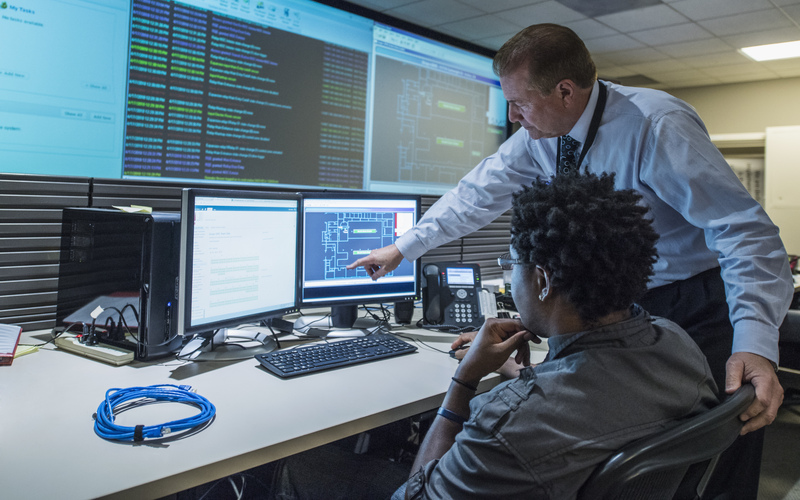Podcast Audio Transcript
Mimi: Hello listeners, this is Mimi; thank you for tuning in to yet another exciting and informative podcast from us at Infosys BPM. Today, we are discussing how business transformation plays a greater role in evolving BPM. And to talk about this, we have here with us, Raja V, VP & Head – Business Excellence. Welcome Raja. How are you?
Raja: I’m doing great, Mimi. Feels great to be on this podcast.
Mimi: Yes indeed, isn’t it? We always love to host leaders like yourself and get your perspectives on various topics.
On to today’s topic. Business transformation is something close to your heart as we all know. To start with, what do clients typically expect from a business transformation project?
Raja: You know, Mimi, understanding client requirements is very important in every transformation initiative. Clients have lots of expectations as I have seen from experience. We aim to rewire an organization’s DNA to reimagine business processes. Increasingly, this has to be powered by innovative digital technologies, to create a genuine competitive edge. I will mention a few important ones.
- Most of our clients expect a holistic approach that addresses various aspects of transformation, including business models, digitalization of operations with domain interventions, and talent transformation, including a cultural change.
- Clients anticipate the strategic deployment of user-empathetic technologies to reimagine business processes. This involves leveraging innovative digital technologies to create a competitive edge.
- You can’t discount the importance of ongoing maintenance. Clients look for ongoing efforts in optimizing and modernizing processes to stay aligned with their evolving business landscape. Clients appreciate mechanisms for quick resolution of bottlenecks, ensuring that any challenges encountered during the transformation are addressed promptly.
- Clients want to know if their partner has a method to the madness when it comes to executing transformation initiatives. The availability of a transformation playbook that incorporates key transformation levers and ready-to-use templates is crucial for guiding the transformation journey.
- They also want visibility of the transformation program. A program management tool with real-time dashboards for effective planning, execution, monitoring, and control of large-scale and small-scale transformations provides this visibility
- Clients would love to have a broad view of project statuses through organizational-level, program-level, and project-level business intelligence dashboards. A clear presentation of financial, statistical, and qualitative benefits associated with the business case or project is essential for them to gauge the success of the transformation. The capability to compare actual performance with target performance and highlight any deviations from the plan helps in making informed decisions during the transformation journey.
So, you see Mimi, clients seek a well-orchestrated and technology-driven transformation approach that aligns with their business objectives, enhances operational efficiency, and delivers tangible benefits.
Mimi:
Absolutely agree Raja. I know that Infosys BPM has a leading approach when it comes to defining and executing transformation goals more effectively.
Could you give us an overview of your approach to business transformation?
Raja: For sure. We have developed a structured approach for business transformation that helps bring in various parts of Infosys BPM together and the client to deliver on our transformation promise. It has three key pillars:
- Firstly, a Transformation Management Office (TMO) with the right skilled program managers. The TMO centrally manages resources, funnels, risk, scope and dependencies, among others.
- Secondly, a transformation playbook with 12 key transformation pillars and 26 ready-to-use templates, as well as an operating model.
- Thirdly, a SaaS-based program management tool – The Infosys Transformation Navigator - with real-time dashboards to track the progress of various projects and their impact on clients’ processes and business metrics.
Our typical approach to delivering transformation for our clients encompasses several critical activities, split into three phases: pre-transformation, transformation, and continuous ongoing maintenance.
In the pre-transformation phase, we do the necessary due diligence to assess the maturity of our client processes and technology landscape and prepare the transformation blueprint. During the transformation phase, we set up a strategic governance structure, onboard resources, and track and report project milestones. As part of the continuous maintenance activity, we conduct risk mitigation and change management activities to maximize the value delivered to clients.
Mimi: Excellent to see this structured approach we have in place, Raja.
The clients must be expecting lots of benefits also from their transformation initiatives. What specific benefits does this approach provide?
Raja: Yes, Mimi, we always aim to provide maximum benefits to our clients. Let me mention some of the most important benefits of our transformation approach:
- Firstly, we provide a broad view of project statuses at organization-level, program-level, and project-level as part of our business intelligence dashboards.
- We generate a clear picture of financial, statistical, and qualitative benefits associated with the business cases and projects.
- We help our clients compare the actual performance of the transformation program with its targeted performance and highlight any deviations from the plan. This allows them to get a clear picture of the progress.
- We also track a transformation maturity score, which gives them an idea of where they stand.
- You can’t discount the importance of effective program governance and quick resolution of bottlenecks. This is another major benefit we offer to our clients.
As you can see, associating with Infosys BPM’s new approach to business transformation is quite beneficial to any organization.
Mimi: Absolutely agree, Raja. In this age of digitalizing operations, such a structured approach is definitely the norm. I would like to thank you for coming to today’s podcast with us and giving your valuable input.
Raja: It was indeed a pleasure, Mimi.
Mimi: Dear listeners, if you enjoyed our podcast today, please don’t forget to share and like it on social media. Our social handles are mentioned on the podcast page. The podcast will be available on various platforms like Google Podcasts and Spotify, in addition to our website.
Also, if you have any queries, do reach out to us through the email address on the podcast description. Watch this space for more exciting podcasts coming up. Once again, thank you for tuning in, stay safe and stay sharp. Have a nice day!






